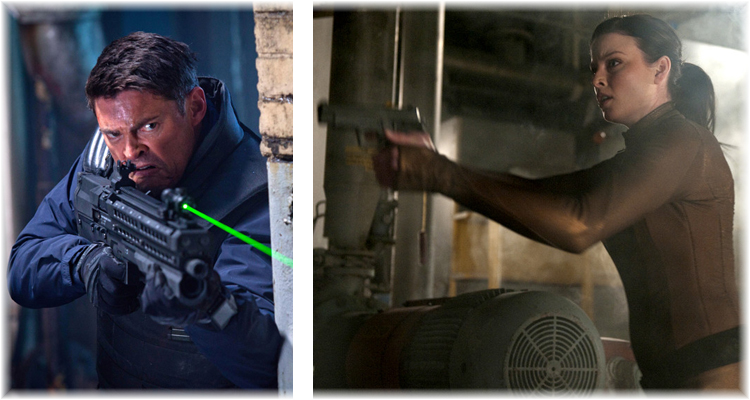‘Almost Human’ vs. ‘Continuum’: A Sci-Fi Series Showdown

Fantasy fans have had a field day in the past few years on television, with shows like “Once Upon a Time,” “Game of Thrones” and the new “Sleepy Hollow.” But with the end of “Fringe,” about the only series that has carried any real science fiction cred has been NBC’s “Revolution.”
Over on the Syfy Channel, the torch has been carried for the past two seasons by time travelling action drama “Continuum.” Just last week that show was joined by the Fox series “Almost Human.” The two shows have many similarities, and enough differences to make most sci-fi fans pick one over the other.
Both shows are set in the future (OK, only parts of “Continuum” are, but I’ll get to that later). Both shows feature cops as the main character. And both shows have a connection to the new “Star Trek” movie series. The most obvious connection comes from “Almost Human,” which features Karl Urban as Det. John Kennex, the damaged Los Angeles cop who has a synthetic leg and an attitude toward the android cops that all officers are paired with that sounds a lot like Will Smith in “I, Robot.” Urban, of course, plays Leonard “Bones” McCoy in the new “Star Trek” movies.
But the star of “Continuum” is Rachel Nichols (from my home state of Maine, no less), who portrays Agent Kiera Cameron, the “protector” (corporate law enforcement officer) from the year 2077, who is stuck in Vancouver, B.C. in 2013 due to a time travel accident. Nichols played the green-skinned Star Fleet cadet Gaila, Uhura’s roommate and one of Jim Kirk’s many lady friends, in the first “Star Trek” reboot movie.
[pullquote_right]There is a big philosophical difference between the two shows, however.[/pullquote_right]Other similarities include having the main character realize early on that he and she each have a personal connection to the larger, overarching conspiracy in the background of the series. The shows are also quite different, however, in setting, plot, writing and directing.
So, how then do the two shows differ from a science fiction standpoint?
First, “Almost Human” is set in 2048, a scant 35 years in the future. Because of the near-future setting, the police drive around in cars, albeit electric by the sound of them, and shoot slightly fancier handguns that fire bullets. “Continuum,” on the other hand, has a flashback (flash forward? Time travel messes up tense. I will refer to it in the terms of the point of view of the main character, Cameron) in each episode to Cameron’s life in 2077, nearly another 30 years further into the future. In that year, the protectors use nanotech-based suits that can stop bullets, turn the protector invisible, turn a sleeve (or any surface one would assume) into a touch-sensitive display, and even become a wearable taser. The protectors have a sidearm that is basically a gun grip that uses nanotech to almost instantly form a weapon that can fire all kinds of projectiles.
When it comes to how much science fiction you get per episode, “Almost Human” has the edge, because it is always set in the future, whereas “Continuum” is mostly set in the present, with flashbacks to 2077 and intrusions into the present of future tech like Agent Cameron’s suit and gun.
There is a big philosophical difference between the two shows, however. The very core premise of “Almost Human” is that cops in the future are paired up with very human-like android partners. Kennex gets paired with an older model from the DRN class, named Dorian, played by Michael Ealy, perhaps best known to us nerds as Det. Sebastian in “Underworld: Awakening.” Unlike the slightly less human and more frightening current MX combat android models, Dorian has the ability to experience emotions and is a full artificial intelligence. The world has humanoid sex bots, and generally synthetic humanoids are very common.
By contrast, “Continuum” has almost no robotics in 2077, but soldiers are bioengineered to be stronger, tougher, and almost impossible to kill Nanotech and bioengineering are the technologies of the future in “Continuum.” The protectors and the future soldiers (some of whom are also trapped in 2013) have neural implants that are brain-machine interfaces that connect to the suit, and to the servers in either the police headquarters or the military HQ.
Cameron actually gets to use that connection in the past, because she meets in 2013 the younger version of the very old genius that created all the protector and soldier tech in 2077. (Oddly enough, Eric Knudsen plays the younger Alec Sadler, and he played Crash of the band Crash and the Boys in “Scott Pilgrim Vs. the World.” So every other episode I expect him to say “This song is called ‘We Hate You, Please Die.’”)
In case you couldn’t gather from the location of “Continuum” and the casting, it is a Canadian production that airs first on Canada’s Showtime network. It has been picked up for a third season “Almost Human,” on the other hand, is a Fox production made by former “Fringe” showrunner JH Wyman, with “Fringe” creator (and, surprise, “Star Trek” rebooter) JJ Abrams as executive producer. So it is more likely to last longer than almost any other new show on Fox — certainly longer than the brilliant “Firefly” that Fox treated horribly.
So, which is the better show? Well, nobody could say yet, with just two episodes of “Almost Human” out in the wild. But both are well written, dealing with serious themes (family, loss and responsibility for “Continuum,” prejudice and identity for “Almost Human.”) And while Rachel Nichols will sometimes break your heart with her completely believable performance as a mother who fears she will never see her young son again, when she is not breaking arms and heads, “Almost Human” may already have the best “two cops being bros” line between the two.
Det. Kennex, when his android partner Dorian brings up his apparent lack of a sex life, says “Well don’t ever scan my testicles again.” Two episodes in and “Almost Human” is already dealing with the, ahem, sensitive topics.



